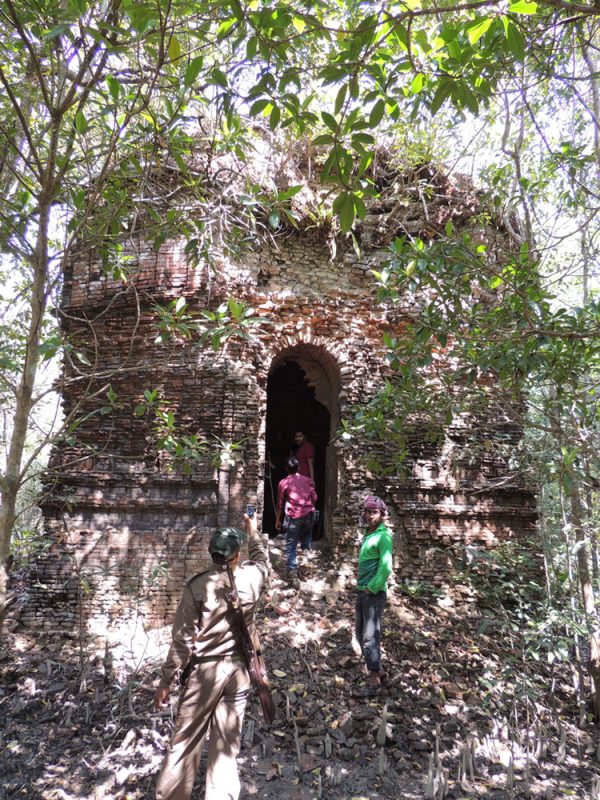As a writer of fiction, it has happened to me many times over the years that scenes, characters and places that I believed to exist only in my imagination have turned out to have real life counterparts. The most recent instance of this occurred a few days ago when I received a message from Dr. Michael S. Steckler, who is a Lamont Research Professor at Columbia University’s Lamont-Doherty Earth Observatory (his specialty is geophysics).
‘I just read your book Gun Island,’ wrote Dr. Steckler, ‘and thought I would write you since I have been studying an actual 17th century Hindu Temple in the Bangladeshi Sundarbans. The Shakher Temple was built by Raja Pratapaditya, the last King of Jessore before he was defeated by the Mughals in 1611.’
Dr. Steckler also sent me the picture posted here.
Readers of Gun Island will understand the reference. It is to a temple in the Indian Sundarban that the book’s narrator, Deen Datta, visits. This is how the temple is described in the book:
The building wasn’t large – no bigger than the familiar thatched huts of the Bengal countryside – and time had not been kind to it. Yet the structure was so unexpected – and so lovely – that the sight fair took my breath away.
The roof had the convex outline of an upturned boat, and it was this, I guessed, that had reminded Nilima of the temples of Bishnupur. Nor was that surprising, for everything about the building – its burnt-siena colour, the shape of the roof, and the panels on its façade – spoke of Bengal’s most celebrated style of architecture, which had originated in the kingdom of Bishnupur in the 17th century.
This is a style which is perfectly attuned to the place in which it was born, in the sense that it echoes the shapes and forms of the Bengal countryside. It also makes ingenious use of the region’s most easily available materials. Rather than aspiring to the grandeur of stone (of which Bengal has very little) it relies instead on brick, made with the delta’s ample supplies of mud and silt. The rich colour of these thin, hard bricks is, to my eyes, one of the glories of the Bishnupuri style.
At the time of writing I didn’t know of any such temple in the Sundarban. It is nothing short of uncanny then that the Shakher temple so closely fits the description: it dates back to the seventeenth century and was indeed built in the Bishnupuri style, with thin, hard bricks, and a convex roof. The only difference is that the temple in Gun Island was dedicated to Manasa Devi, the Goddess of Snakes, while the Shakher temple is consecrated to Ma Kali. Also, fortunately, the Shakher temple, unlike its fictional counterpart, has survived, and an annual puja is still held there.
The Shakher temple is said to be the only ‘standing ancient structure’ in the Sundarban and is located at ‘Shakher Tek about one kilometer away from the east bank of the Sibsa River’ in Bangladesh. [Sarker et al. 2012]
It is interesting also that the subject that Dr. Steckler and his team study is one that I have long been interested in: land subsidence in the Bengal Delta. Here are the conclusions of a paper that Dr. Steckler co-wrote in 2014:
The Ganges–Brahmaputra river delta, with 170 million people and a vast, low-lying coastal plain, is perceived to be at great risk of increased flooding and submergence from sea-level rise. However, human alteration of the landscape can create similar risks to sea-level rise. Here, we report that islands in southwest Bangladesh, enclosed by embankments in the 1960s, have lost 1.0–1.5 m of elevation, whereas the neighboring Sundarban mangrove forest has remained comparatively stable. We attribute this elevation loss to interruption of sedimentation inside the embankments, combined with accelerated compaction, removal of forest biomass, and a regionally increased tidal range. One major consequence of this elevation loss occurred in 2009 when the embankments of several large islands failed during Cyclone Aila, leaving large areas of land tidally inundated for up to two years until embankments were repaired. Despite sustained human suffering during this time the newly reconnected landscape received tens of centimeters of tidally deposited sediment, equivalent to decades’ worth of normal sedimentation. Although many areas still lie well below mean high water and remain at risk of severe flooding, we conclude that elevation recovery may be possible through controlled embankment breaches.
[Auerbach, L. W., S. L. Goodbred Jr., D. R. Mondal, C. A. Wilson, K. R. Ahmed, K. Roy, M. S. Steckler, C. Small, J. M. Gilligan and B. A. Ackerly. ‘Flood risk of natural and embanked landscapes on the Ganges–Brahmaputra tidal delta plain.’ Nature Climate Change, Jan. 5, 2015.]
Here are some other links to the work that Dr. Steckler and his team have been doing.
https://www.youtube.com/watch?v=riXfJeI5mMI

